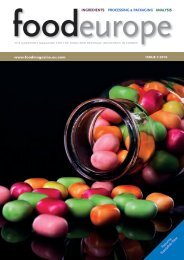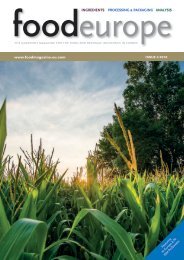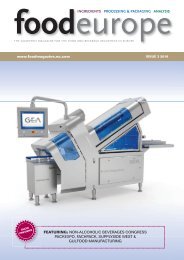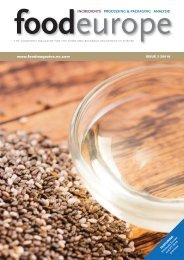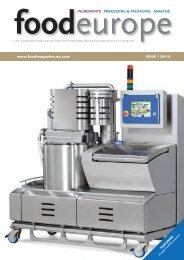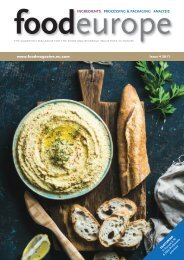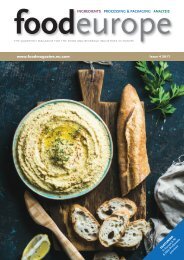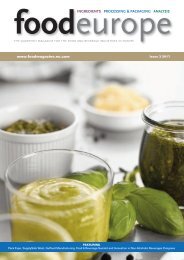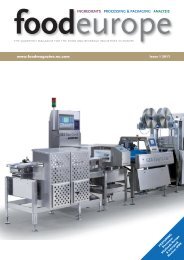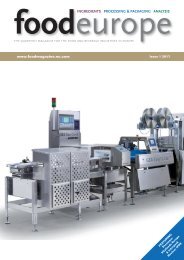food
Create successful ePaper yourself
Turn your PDF publications into a flip-book with our unique Google optimized e-Paper software.
40<br />
ingredients<br />
Food additives<br />
– regulation in action<br />
Since the Food Standards Agency was established in April 2000 its aim has been to be trusted<br />
as the UK’s most reliable source of advice and information about <strong>food</strong>. We want to protect and<br />
improve the safety of the <strong>food</strong> people eat, and to make it possible for people to choose a<br />
healthy diet.<br />
A key part of the Agency’s work is<br />
to ensure the use of <strong>food</strong><br />
additives does not compromise<br />
<strong>food</strong> safety or mislead consumers.<br />
While overall additive legislation is<br />
negotiated in Europe, the FSA has<br />
responsibility for national<br />
implementation in the UK.<br />
Underpinning the Agency’s work<br />
on <strong>food</strong> additives is its programme<br />
of research and surveillance.<br />
Developing the right tools<br />
The Agency commissions scientific<br />
research to help ensure that its<br />
policies and advice are based on<br />
the best available science. Its<br />
research and surveillance<br />
programmes on <strong>food</strong> additives aim<br />
to support consumer protection by<br />
providing the best possible<br />
scientific evidence to ensure that<br />
the use of <strong>food</strong> additives does not<br />
prejudice <strong>food</strong> safety. The<br />
research programme also aims to<br />
develop and refine methods of<br />
analysis that can be used during<br />
enforcement and provide<br />
information and advice.<br />
Enforcing <strong>food</strong> additive legislation<br />
and conducting surveillance<br />
requires reliable methods for<br />
detecting the levels of additives<br />
used in <strong>food</strong>s.<br />
The FSA currently has a project<br />
looking at the possibility of using<br />
DNA techniques to detect<br />
different gelling additives. In the<br />
past these additives have been<br />
difficult to detect, as their<br />
chemical structure is very similar.<br />
However, they originate from<br />
different plants, which have<br />
different DNA. The Agency has<br />
commissioned a project to look at<br />
the feasibility of using these<br />
techniques as a future<br />
enforcement tool.<br />
The Agency also commissions<br />
research to refine and validate<br />
existing methodology. For<br />
example, the Agency is currently<br />
looking at the extraction of colours<br />
from high protein <strong>food</strong>s such as<br />
Red 2G (E128) from burgers. This<br />
has been problematic in the past<br />
due to interactions between the<br />
added colours and proteins in the<br />
<strong>food</strong>.<br />
Watching what we eat<br />
Another main role is to ensure<br />
that permitted additive levels do<br />
not compromise <strong>food</strong> safety. To<br />
meet these requirements the<br />
Agency has a programme of<br />
surveillance looking at the usage<br />
of additives in <strong>food</strong>s. The Agency<br />
is able to use the information<br />
gathered from surveys to ensure<br />
manufacturers are complying with<br />
maximum permitted levels and to<br />
refine information on the levels of<br />
additive consumed.<br />
Last year a survey aimed at<br />
pregnant women looked at the<br />
levels of caffeine in hot<br />
beverages. It examined the levels<br />
of caffeine in 400 samples of tea<br />
and coffee prepared by consumers<br />
and purchased from retail<br />
settings. The survey indicated that<br />
while there was a wide range of<br />
caffeine levels in hot beverages,<br />
the previous advice to pregnant<br />
women, to limit caffeine intake<br />
following Agency guidelines,<br />
remained appropriate.<br />
Think national act local<br />
While the FSA implements<br />
European standards nationally, the<br />
day to day responsibility for<br />
enforcement of <strong>food</strong> legislation in<br />
the UK lies with Local Authorities.<br />
They are required to prepare a<br />
<strong>food</strong> sampling policy and<br />
programme which takes national<br />
and local consumer issues into<br />
account and considers the types<br />
of businesses and <strong>food</strong>s produced<br />
in their area. The FSA assists<br />
Local Authorities in the coordination<br />
of this sampling work<br />
A recent survey examining levels<br />
of colours in ready-to-drink soft<br />
drinks is a good example of how<br />
this relationship works in practice.<br />
The survey covered 201 samples<br />
collected from throughout the UK<br />
and from a range of retail outlets<br />
including supermarkets, small<br />
retailers and vending machines.<br />
Analysis showed four samples<br />
contained levels of colours above<br />
the maximum permitted limit and a<br />
further four contained colours<br />
which were not labelled.<br />
Manufacturers and local<br />
enforcement authorities were<br />
informed and the necessary action<br />
was taken.<br />
Looking to Europe<br />
It can be easy to forget that these<br />
days up to 95% of <strong>food</strong><br />
regulations are not set in the UK<br />
but in Europe, with the FSA<br />
representing the views of the UK.<br />
Before any additive is permitted<br />
for use in <strong>food</strong> in Europe it must<br />
go through a long process of<br />
evaluations and controls. The first<br />
step is a rigorous safety<br />
evaluation by the independent<br />
scientific committees that advise<br />
the European Commission, most<br />
notably the European Food Safety<br />
<strong>food</strong> spring 2005




